Bryggen is the historic quayside in the city of Bergen on the west coast of Norway. Bergen was founded in 1070 AD, the city is one of the oldest trading ports in northern Europe. The quayside Bryggen was a centre for international trade. During the first 200 years of its existance, Bryggen was kept in Norwegian hands. The first German traders came to Bryggen in the 1230's. The city of Bergen was part of the Hanseatic League, also known as the Hansa, an economic alliance of trading cities along the coast of Northern Europe. Together with Brugge, London and Novgorod, Bergen was one of the overseas ports of the Hanseatic League. Bryggen is the oldest part of Bergen and consists of 58 original wooden buildings. The Leprosy Museum in Bergen houses the Leprosy Archives of Bergen, the archives were inscribed on the UNESCO Memory of the World Register. The University of Bergen Library houses the Sophus Tromholt Collection, this unique photo collection of the landscape of Finnmark and the Sami people was inscribed on the UNESCO Memory of the World Register. Bryggen became a UNESCO World Heritage in 1979.
www.werelderfgoedfotos.nl © Copyright World Heritage Photos
The iconic waterfront of Bergen, the houses of the quayside Bryggen reflected in the waters of the fjord. Bryggen is the historic quayside in the city of Bergen on the west coast of Norway. The city of Bergen is situated on the Byfjorden, the 'City Fjord'. Bergen was founded in 1070. Bergen is one of the oldest trading ports in the north of Europe. The quayside Bryggen was a centre for international trade. The Bryggen gained the status as a UNESCO World Heritage in 1979.
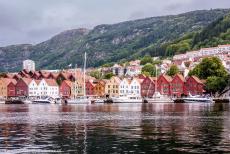
The iconic waterfront of Bergen, the houses of the quayside Bryggen reflected in the waters of the fjord. Bryggen is the historic quayside in the city of Bergen on the west coast of Norway. The city of Bergen is situated on the Byfjorden, the 'City Fjord'. Bergen was founded in 1070. Bergen is one of the oldest trading ports in the north of Europe. The quayside Bryggen was a centre for international trade. The Bryggen gained the status as a UNESCO World Heritage in 1979.
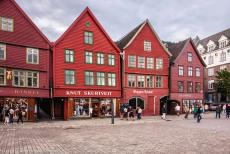
The Hanseatic buildings of Bryggen in Bergen. From the 14th to the mid-16th century, the city of Bergen was an important part of the trading network of the Hanseatic League, founded by the Germans. The first German traders came to Bergen in the 1230s, after several years, the traders were allowed several privileges: the possibility to purchase property, to stay in the winter and to salvage their sunken ships. Bryggen was little by little taken over by the Hanseatic traders.
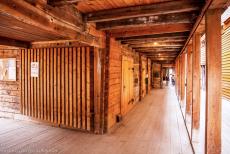
One of the narrow alleyways between the wooden houses of the quayside Bryggen. The area of Bryggen is the oldest part of the city of Bergen. Bryggen is the Norwegian word for quayside. The quayside consists of 58 original wooden buildings. The wooden buildings were built around a courtyard, the so-called gård. The warehouses were filed with goods, such as stockfish, still an important export product of Norway.
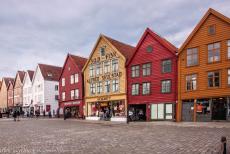
The characteristic coloured houses on the quayside Bryggen in the city of Bergen. Bergen was one of the Hanseatic League's overseas ports together with Brugge, London and Novgorod. The Hanseatic methods and manner of trade were followed in Bryggen. The Hanseatic League was founded by Germans merchants, they dominated trade along the coast in Northern Europe for several centuries.
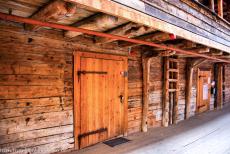
A view down one of the the narrow alleys of Bryggen, the houses were combined living quarters and warehouses. The gable porch provided shelter from rain and snow. The area of Bryggen is the oldest part of the city of Bergen. Many fires has damaged or destroyed the wooden houses of Bryggen. The last disastrous fire was in 1955, it destroyed one-third of the quayside Bryggen. The remaining 58 wooden houses of Bryggen were carefully restored.
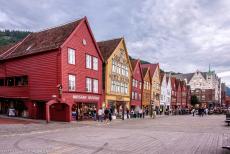
The Holmedalsgården of Bryggen. Bergen is one of the oldest trading ports of northern Europe. The first German traders came to the city in the 1230's. In the 14th century, Bergen became part of the Hansa, an economic alliance of trading cities along the coasts of Northern Europe. During the first two hundred years of its existence, the quayside Bryggen was kept in Norwegian hands. The Hanseatic Museum and Schøtstuene show how the German merchants lived and worked.
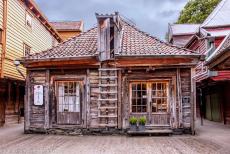
The Bottega along the Bellgården in Bryggen is a three-hundred year old wooden building. The warehouses of Bryggen were filled with goods such as stockfish, clipfish and corn. Today, the buildings of Bryggen houses galleries, shops, bars, pubs, restaurants and museums. Wandering through the alleys of Bryggen gives the feeling of wandering through a medieval village. Bryggen is also known as Tyskebryggen, the German Quayside.
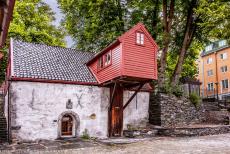
Bryggen: Towards the back of the courtyard, the gård, there are storage rooms of stone. These storage rooms were built of stone so they would be fireproof. The storerooms were used as an individual or collective warehouse. Bryggen is the historic quayside in Bergen on the west coast of Norway. Bryggen is the oldest part of Bergen, the second largest city in Norway. Bryggen was inscribed on the UNESCO World Heritage List in 1979.
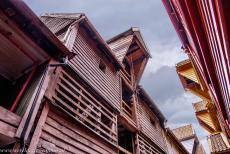
The hoist system for loading and unloading goods from the wooden warehouses on the historic quayside Bryggen in the city of Bergen. German merchants of the Hanseatic League, also known as the Hansa, lived and worked in Bryggen from the 1230s up to the 17th century. They traded dried fish, corn, clothes and many other wares. In 1754, the operations of the Hanseatic League at Bryggen ended when the properties passed into the control of Norway.
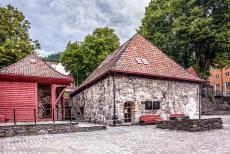
Bryggen: A storage room of stone in the courtyard, the gård. Bryggen is the historic quayside in Bergen, dating back to medieval times. Today, Bryggen is a tourist attraction, the former storage rooms of the Hanseatic League now houses pubs, shops, museums, galleries and restaurants. The city of Bergen is situated about 309 km from Oslo, the capital city of Norway. In 1979, the historic quayside Bryggen in Bergen was listed as the first UNESCO World Heritage in Norway.
